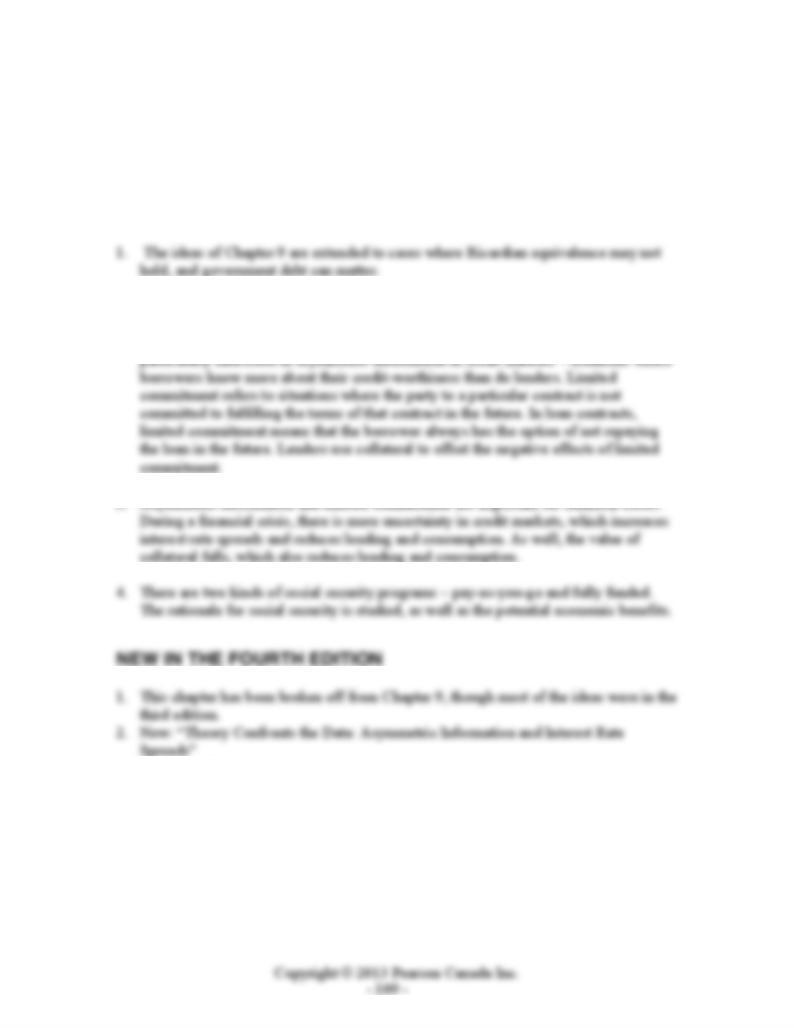
CHAPTER 10
Credit Market Imperfections: Credit Frictions,
Financial Crises, and Social Security
KEY IDEAS IN THIS CHAPTER
2. Two key credit market frictions are asymmetric information and limited commitment.
There is asymmetric information when participants in a particular market, or the two
parties to a particular exchange have different information. In this chapter we are
3. Charts and tables have been updated to reflect new data.
TEACHING GOALS
Credit market frictions and social security may not appear to be related issues, so it is
important to stress that this chapter extends the ideas of Chapter 9, by considering
instances where credit markets are not perfect. In a world with frictionless credit markets
(as considered in Chapter 9), there would be no financial crises or social security, for
example.

Instructor’s Manual for Macroeconomics, Fourth Canadian Edition
The first key idea is that credit market frictions are typically reflected, in our two-period
model, in a kinked budget constraint for the consumer. The chapter begins by simply
considering a kinked budget constraint, where the consumer borrowers at a higher interest
rate than he or she receives as a lender, without worrying about why that may be so.
Then, asymmetric information is introduced, to show how that leads to the kinked budget
constraint, and this leads naturally to issues related to the financial crisis, particularly the
increase in interest rate spreads, which in this instance is explained by an increase in
credit market uncertainty.
With limited commitment, we again obtain a kinked budget constraint, but now the
budget constraint shifts in an interesting way with a decrease in the value of collateral.
The drop in housing prices in the United States was a key element of the financial crisis,
and the model shows how this can be connected to a decrease in the demand for
consumption goods.
Finally, the chapter considers social security systems – pay-as-you-go and fully-funded.
The model is a simplification of an overlapping generations model, but the idea is the
same. Social security can be welfare-enhancing for everyone, so long as the population
grows at a sufficiently high rate. Fully-funded social security is harder to justify
economically, however. If this type of program is simply forced savings, then it cannot
make anyone better off, as it removes choice. However, social security can always be
justified by appealing to commitment, in that people may not save adequately if they
know that the government will always be willing to look after them old age.
CLASSROOM DISCUSSION TOPICS
Encourage students to think about the credit market frictions that exist in the world.
Individuals cannot borrow all they would like to at market interest rates; we cannot
borrow at the same interest rates at which we lend; consumers, firms, and governments
sometimes default on their debts; collateral is used in lending contracts; borrowers
sometimes have better information than do lenders about their credit-worthiness.
The financial crisis occurred recently, so students may remember some of the key details
of what happened. Get the students to recall what was happening in credit markets in the
world during the crisis, so that these details can be related to the models studied in the
chapter. Recall that interest rate spreads increased, lending contracted, and there were
credit market “freezes” in some segments of the market. Students should be encouraged
to think about the implications of this for consumption expenditure.
Students should be familiar with at least the existence of social security programs in the
world, and particularly the Canada Pension Plan (CPP). A discussion could start with the
details of the CPP and how it is financed. What reasons could we think of for the
existence of social security? Is this simply income redistribution, or is there something
deeper going on here. Why would private credit markets fail to the extent that social
security might be welfare-enhancing?
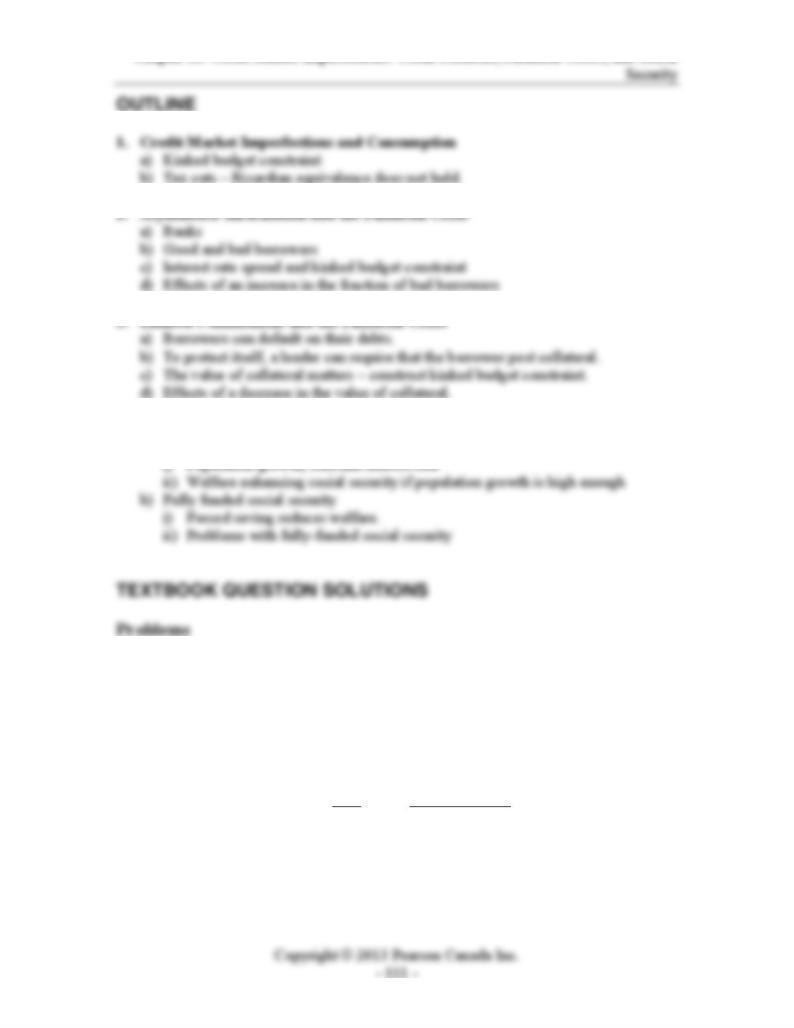
Chapter 10: Credit Market Imperfections: Credit Frictions, Financial Crises, and Social
4. Ricardian Equivalence, Intergenerational Redistribution, and Social Security
a) Pay-as-you-go social security
1. In this economy, good borrowers and lenders always pay their taxes. In the current
period, bad borrowers take out loans, so as to mimic good borrowers, and they
likewise pay their taxes, so as not to reveal themselves as bad. However, in the future
period bad borrowers do not pay their taxes. Therefore, if t and t’ are, respectively,
the taxes paid by lenders and good borrowers, the government’s present-value budget
constraint is
r
tbaaN
Nt
r
G
G+
−+
+=
+
+
1
'])1([
1
'

Instructor’s Manual for Macroeconomics, Fourth Canadian Edition
'
1
)1)(1(
)
1
'
(
1
1
't
r
ba
r
G
G
N
y
r
t
tywe +
−−
−
+
+−=
+
−−= .
2. a) The present value of government spending can at most be
,
11
'*
r
pH
NNy
r
G
G+
+=
+
+
where N is the number of consumers, and y* is the minimum income of any
consumer in this economy. That is, r
pH
+1 is the present value of the taxes that can
be paid by the consumer in the future, and with what can be borrowed to pay taxes
in the present. Then, if all consumers pay the same taxes, the additional income
that the government can compensate is the minimum income that any consumer
has in the present.
b) A consumer’s collateral constraint can now be written
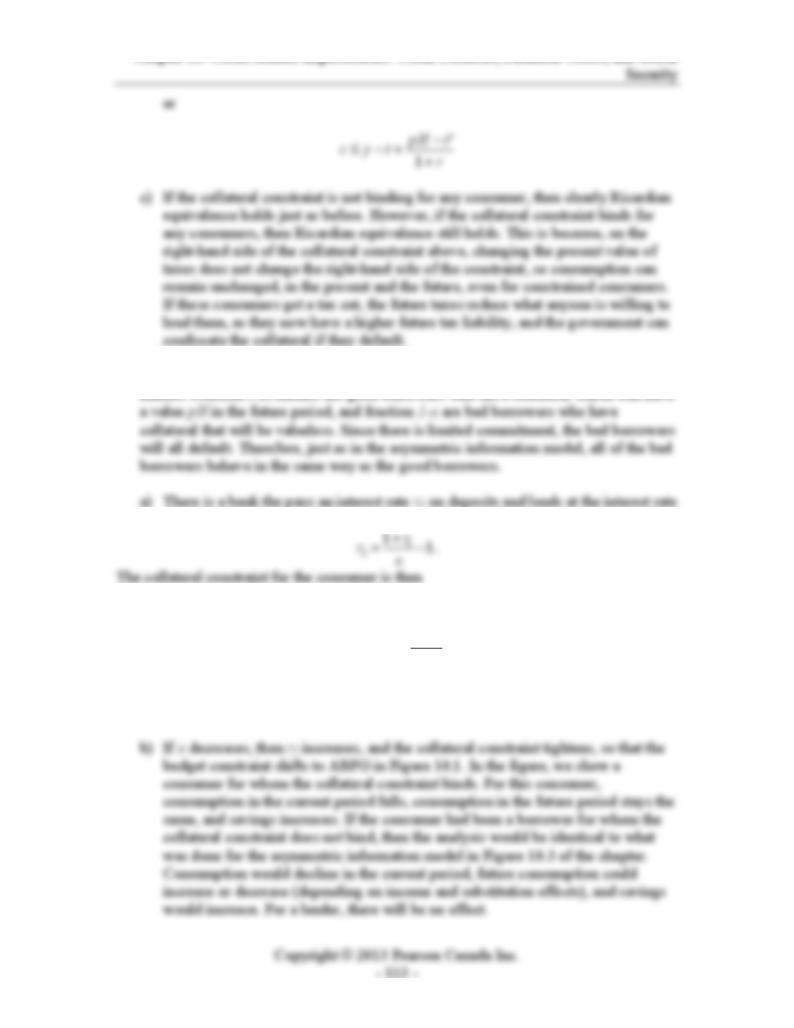
Chapter 10: Credit Market Imperfections: Credit Frictions, Financial Crises, and Social
3. This problem combines asymmetric information with limited commitment in the loan
r2. Just as in the asymmetric information model, in equilibrium
2
(1 )rs pH−+ ≤ ,
Which can be rewritten as
2
1
p
H
cyt r
≤−+
+.
As well, if s > 0, then a consumer faces the interest rate r1, and if s < 0, then he or she
faces the interest rate r2. Thus, the budget constraint has two kinks, as depicted by ABDE
in Figure 10.1.
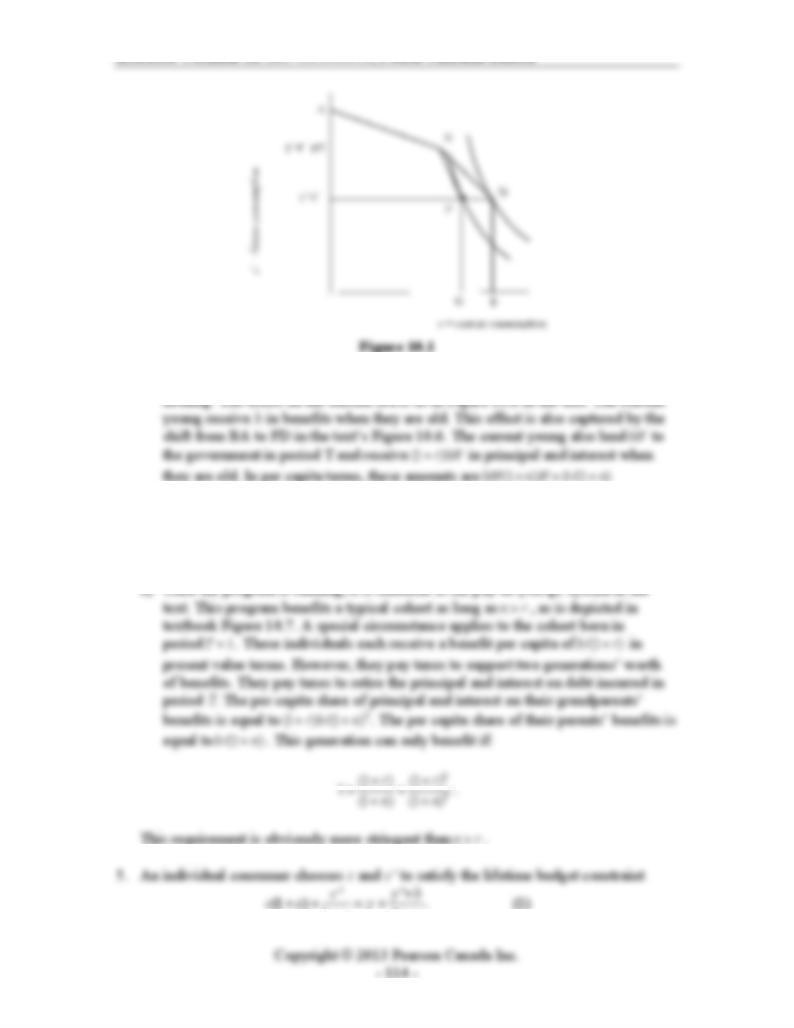
Instructor’s Manual for Macroeconomics, Fourth Canadian Edition
4. a) When the program is first instituted, the current old receive b in benefits and pay
and (1 ) /(1 ) (1 ) /(1 )rbN nN rb n++=++ respectively. However, this borrowing and
lending is represented in Figure 10.6 as movements along the budget line. Unless
there is a change in the real interest rate, there is no additional shift in the budget
line. Therefore, both these generations unambiguously benefit from the program.
(1 ) .
11
rr
++
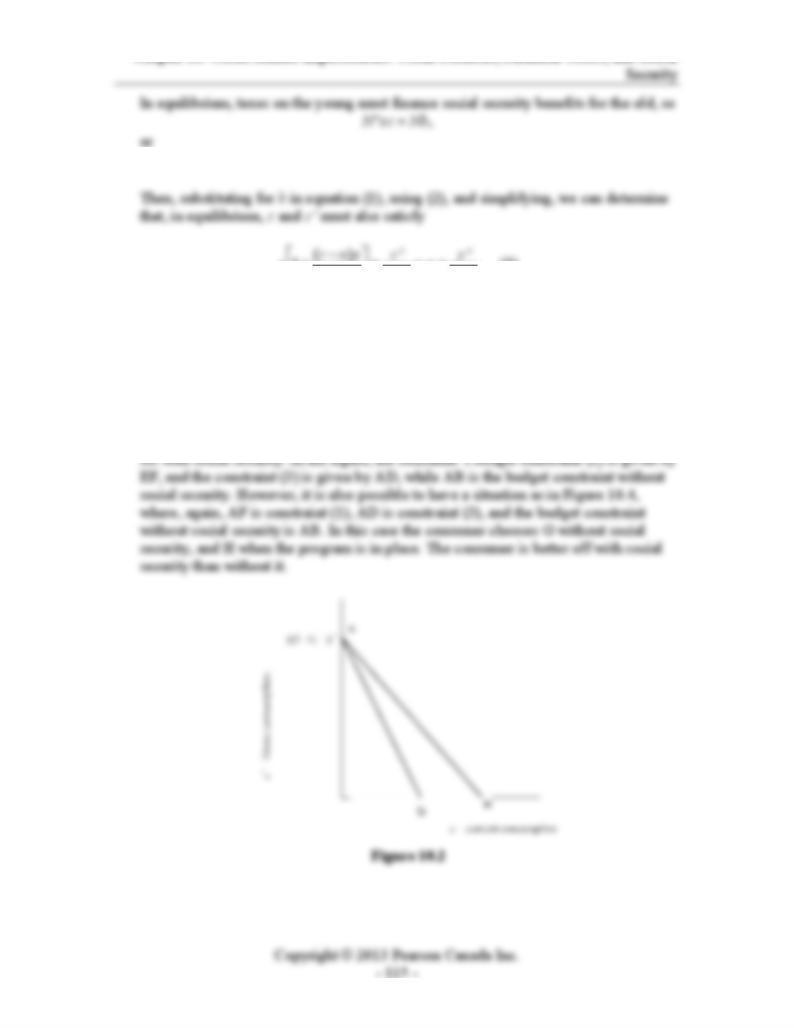
Chapter 10: Credit Market Imperfections: Credit Frictions, Financial Crises, and Social
(1 ) .nsc b+= (2)
() ' '
1.
11 1
cy
rr r
++=+
++ +
(3)
First, consider the case where rn>. Then, in Figure 10.2, without the social security
program, the consumer chooses point D on budget constraint AB. But with the social
security program, the consumption bundle chosen by the consumer must satisfy (3),
i.e. it lies on AF in Figure 10.2. But point D is strictly preferred by the consumer to
any point on AF, so the social security program cannot make consumers better off if
rn>. Then, consider the case where rn<. It is possible that we could have a
situation as in Figure 10.3, where the consumer chooses G in the absence of the
program, and H with the social security program so that, again, the consumer is worse
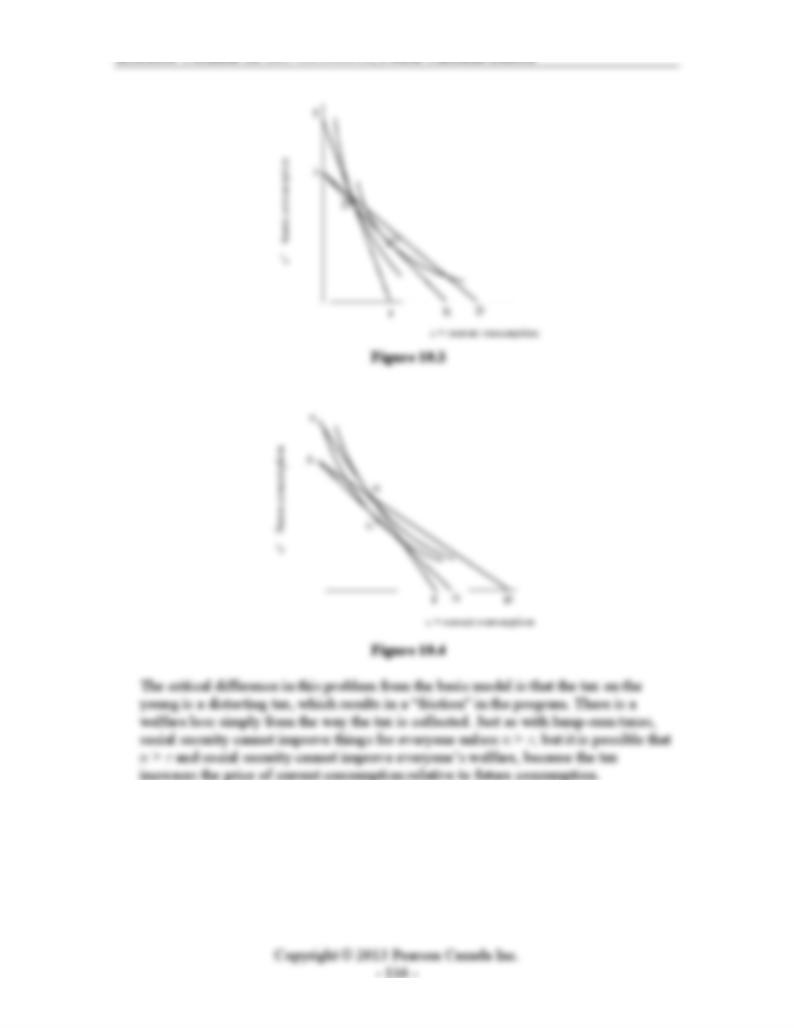
Instructor’s Manual for Macroeconomics, Fourth Canadian Edition
6. a) Under this change in government policy, the government debt issued in period T
is
NbDT=,
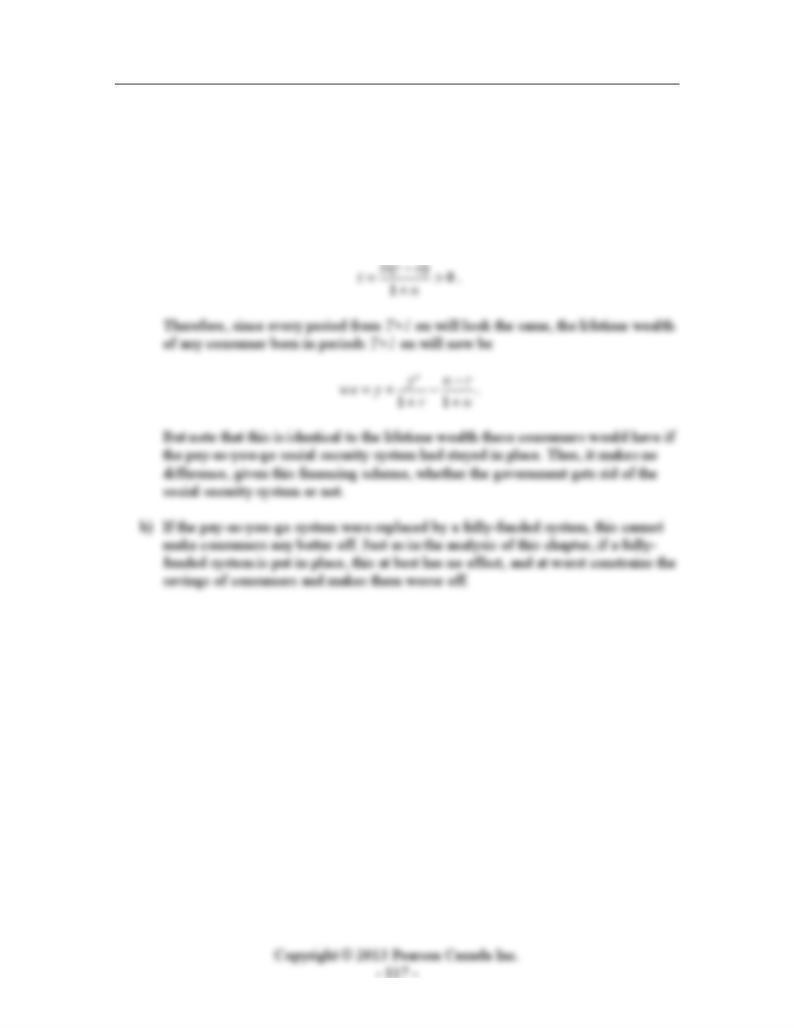
Chapter 10: Credit Market Imperfections: Credit Frictions, Financial Crises, and Social
Security
Then, in period T+1, the interest and principal on the debt will be Nb(1+r), and
the quantity of new debt issued will be N’b. Therefore, the total tax paid by the
old consumers in period T+1 is
bNrNbtN ')1(' −+= ,
where t is the tax paid by each old consumer in period T+1. Therefore, solving the
above equation for t and simplifying, we get